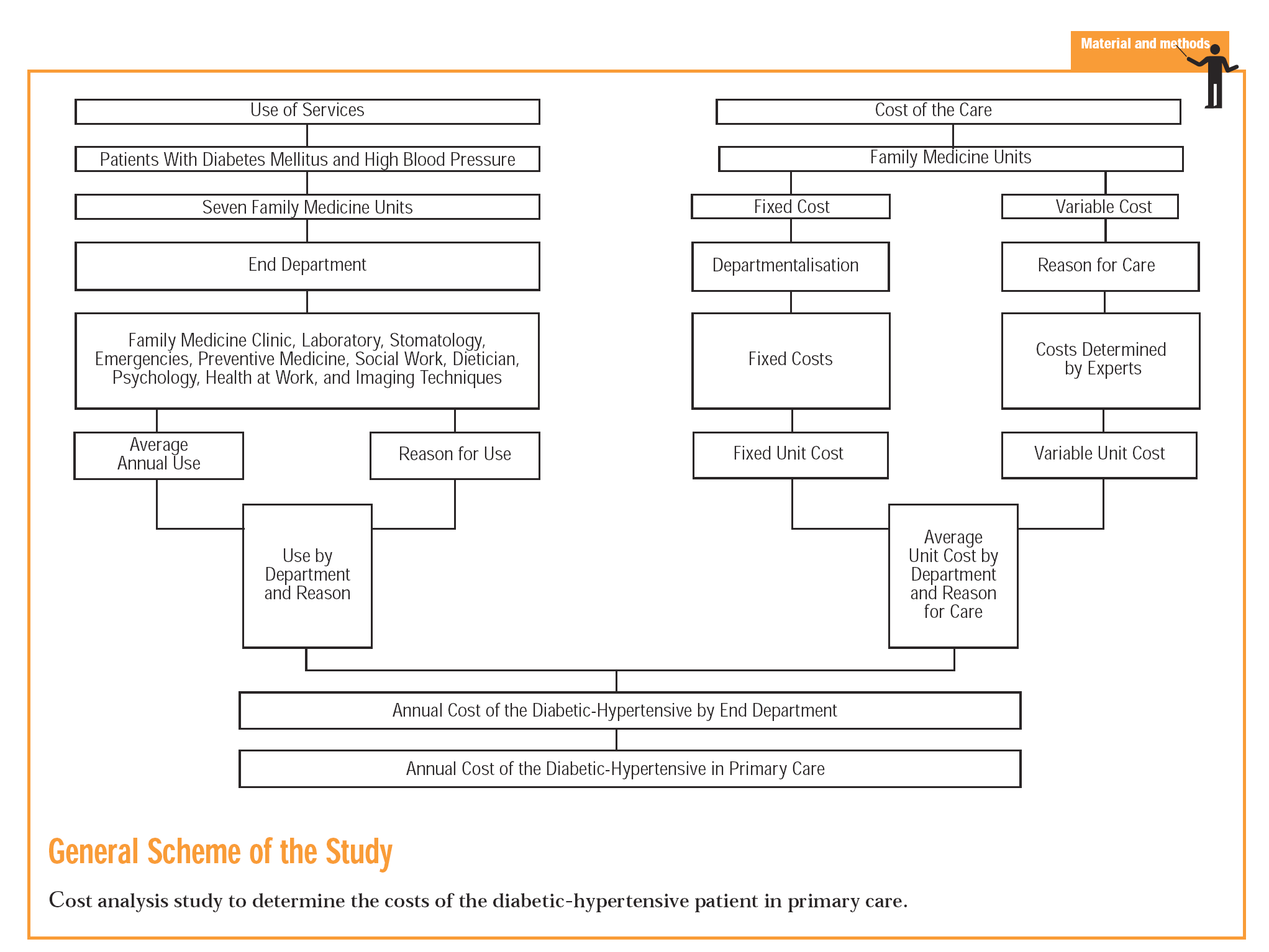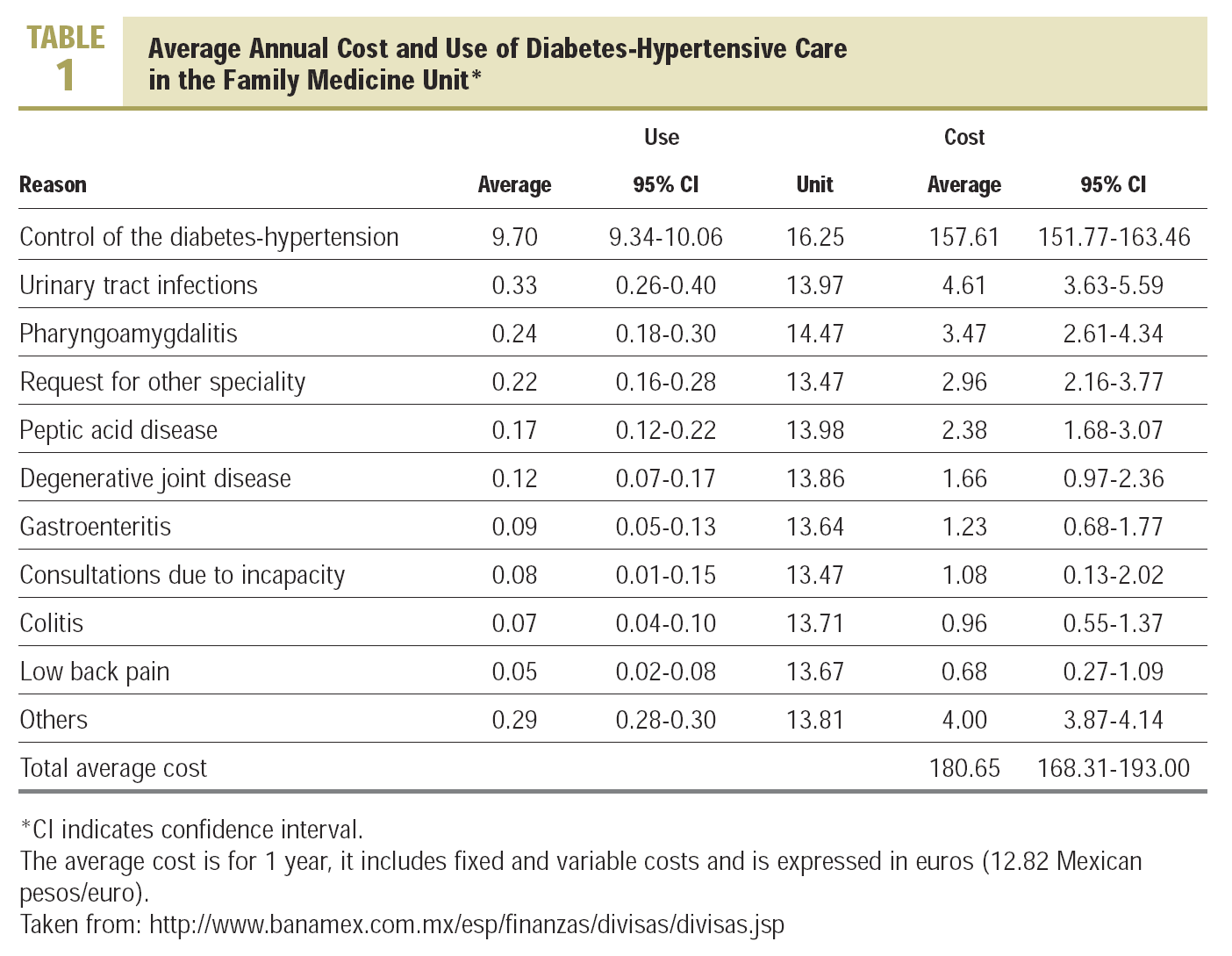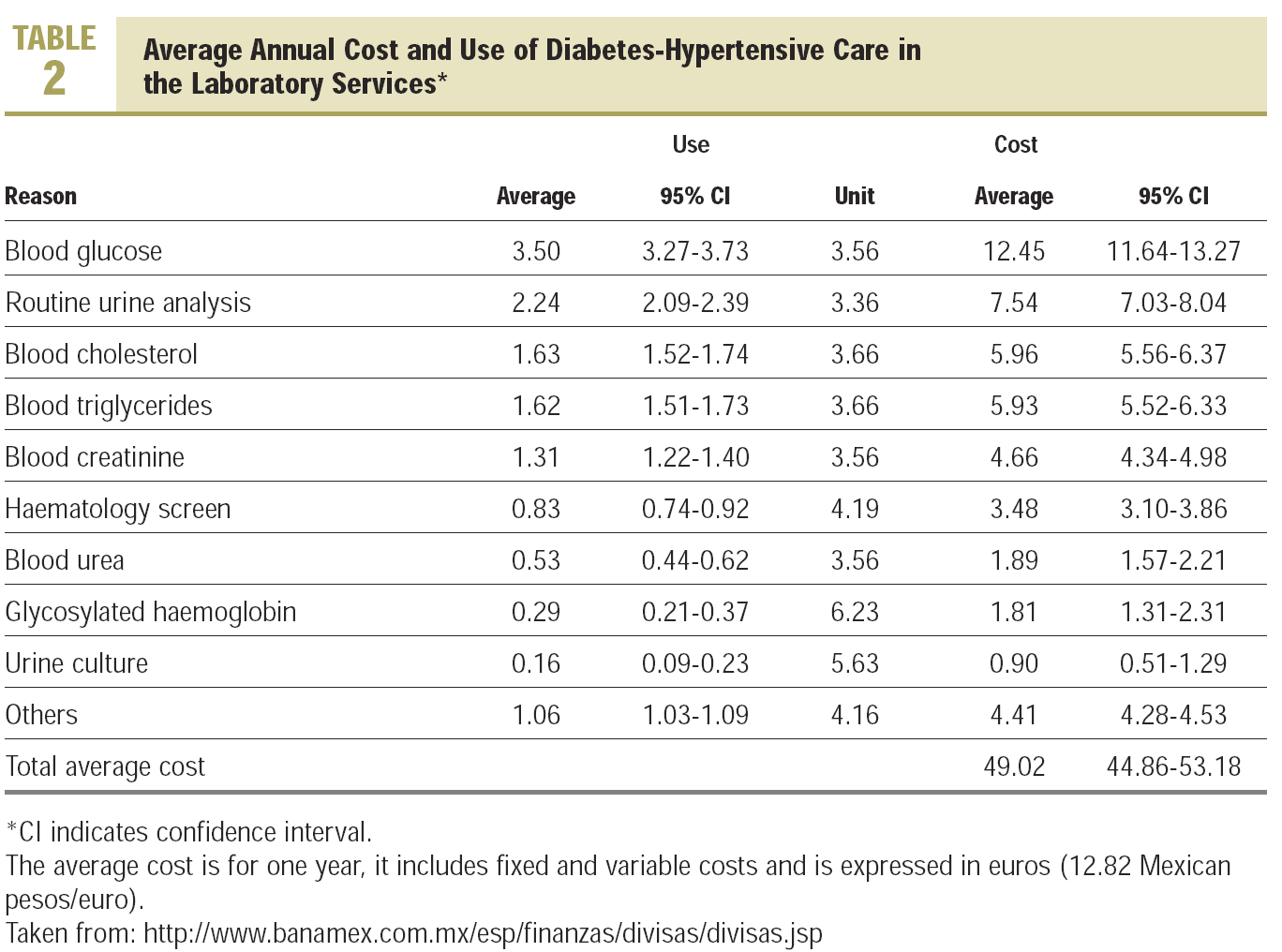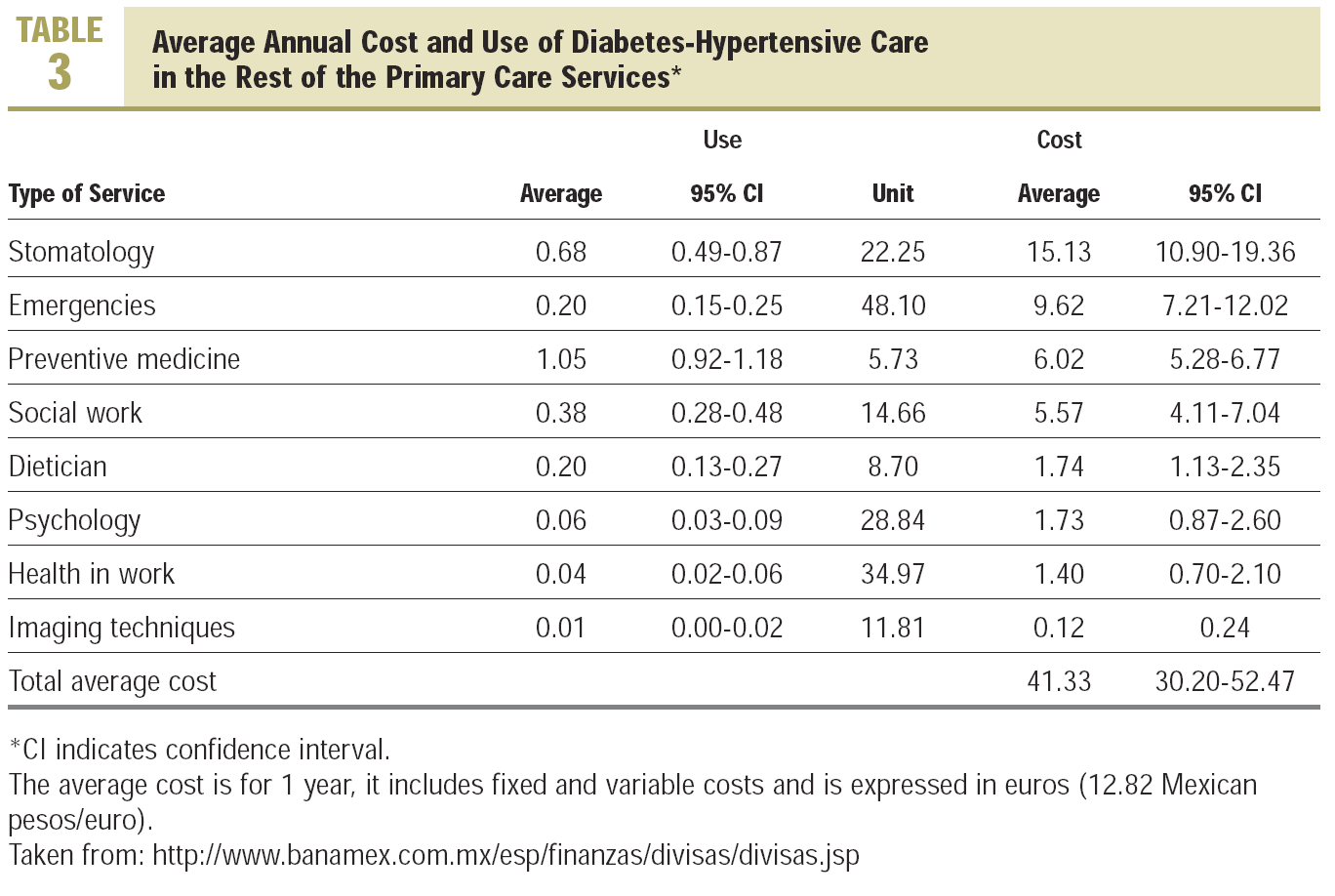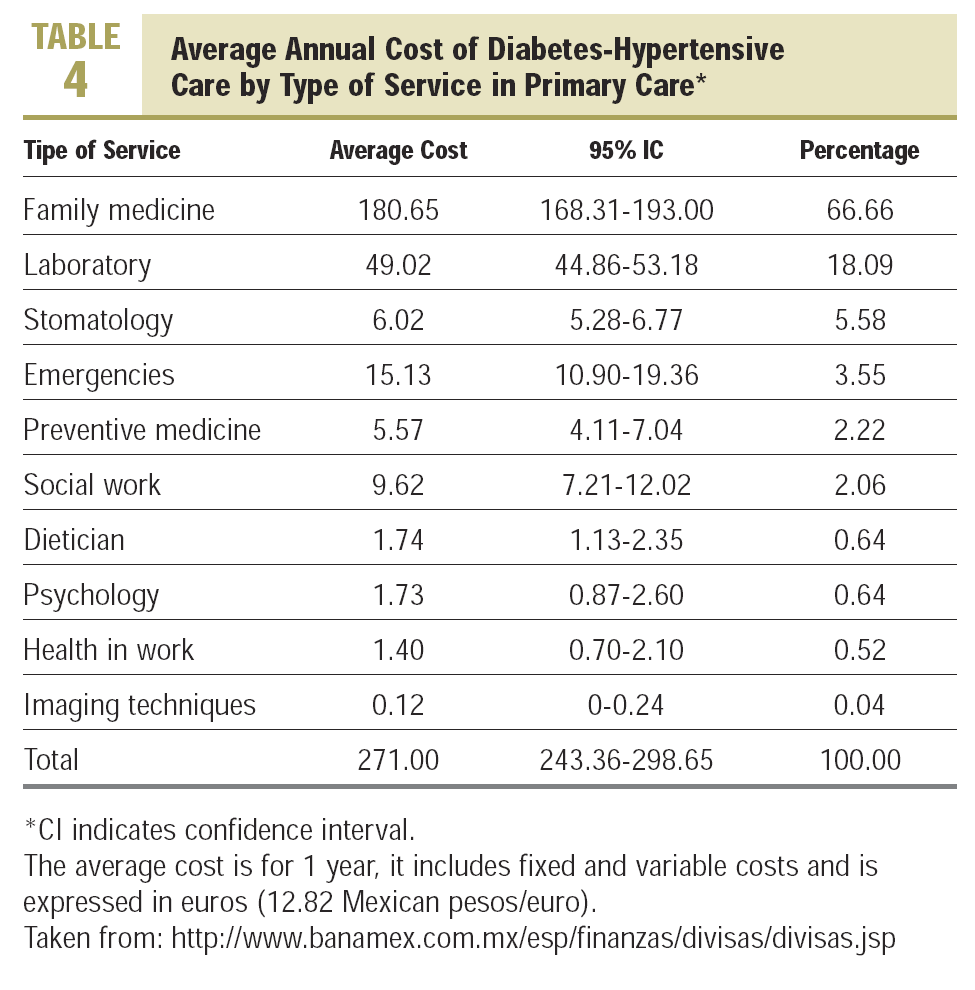Introduction
The rising costs of health care and the changing demographic and epidemiological profile represents a challenge to the health system. The increase in the prevalence and the diagnosing of chronic degenerative diseases at an earlier age has led to a costly reason for care that competes with the budget assigned to health; hence the need to establish strategies for the efficient use of resources.1-3
Diabetes mellitus and systemic arterial hypertension have been identified as making a much greater use of the health services and economic resources.4 In this respect, information on the costs of caring for the patient with diabetes or hypertension have been published.5-8
The association between diabetes mellitus and arterial hypertension has been described from an epidemiological point of view, and it has been found that the prevalence of hypertension in a population of diabetics varies between 66% and 71%.9,10
In this context, the objective was to determine the cost of caring for the diabetic-hypertensive patient in primary care in Mexico.
Methods
A cost analysis of health care in a population with diabetes-hypertension was carried out in the largest Social Security institution in Mexico. The study included the profile of use of the service and the cost of the care. During the period August-November 2004, the clinical histories of the population belonging to 7 primary care units in the metropolitan area of the city of Querétaro, México, were analysed. All those who were registered at the primary care unit for 1 year or more were included, with diabetes and hypertension for 1 year or more and at least 1 consultation recorded in this period.
The sample size was calculated from the formula of means for an infinite population, z=1.64, standard deviation (SD) =0.8 and d=0.1. The estimated number (N=172) was distributed proportionally between the 7 primary care centres, and within each one a simple randomisation technique was applied, using the list of diabetic-hypertensive patients as the reference sample.
For the estimation of fixed unit costs, the departmentalisation adjusted for the productivity for 1 year was used, end and general departments were identified. Material resources considered as consumables were (furniture, equipment, and instruments), physical (infrastructure), human (personnel costs), and consumables (office material, telecommunications, fuel, electricity, and water). To assign the resources used in general departments a weighting was given to each end one, depending on the specific weight of each end department for each type of consumable.
The estimation of the variable unit cost was carried out using the micro-costing technique. To define the type and amount of consumables required for each intervention--reason for consultation, laboratory analyses or radiodiagnostics--a group of experts in the respective areas were consulted. Drugs, cure materials and reagents were considered as consumable variables.
The unit cost by reason for care was determined by adding the fixed unit cost and the variable unit cost.
In each department the mean use by reason for the care was added to the respective unit cost to obtain the mean cost per department. The annual mean cost per patient was obtained by adding the mean costs of each department included.
The socio-demographic variables and the health characteristics were also studied. The analysis included percentages, means and confidence intervals (CI) for the use, which were associated with the mean cost.
Results
The mean age of the population studied was 61.31±9.90 years, the majority being female (80.8%) and with a primary education or less in 80.6% of cases.
The time of having the diabetes was 11.10±7.24 years and arterial hypertension 10.97±6.23 years.
The mean glucose levels were 175.28±70.16 mg/dL, with 41.3% of the values <140 mg/dL; the diastolic blood pressure was 83.79±5.07 mm Hg, with 57.6% <85 mm Hg; 28.0% were overweight and 52.9% were obese.
The annual average use of the diabetic-hypertensive patient in family medicine was 11.36±3.94 care sessions. The annual cost was €180.65 (95% CI, 168.31-193.00), that corresponding to monitoring care was €157.60 (95% CI, 151.77-163.46), followed by urinary tract infections, €4.61 (95% CI, 3.63-5.59). The reasons for care of the diabetic-hypertensive patient, the average use and cost per reason are presented in Table 1.
The number of laboratory studies was 13.17±5.47, with an annual cost of €49.02 (95% CI, 44.86-53.18); of this, €12.45 (95% CI, 11.64-13.27) corresponds to blood glucose analysis. Table 2 shows the reasons for the laboratory test, the use and cost per reason.
Of the rest of the primary care services, the most used was preventive medicine, with an annual average of 1.05±1.06 visits; the highest cost was for stomatology, with €15.13 (95% CI, 10.90-19.36). Table 3 shows the use and the annual cost per type of service.
The annual cost of care for the diabetic hypertensive patient is €271 (95% CI, 243.36-298.65); the highest cost is for family medicine, with €180.65 (95% CI, 168.31-193.00). The annual cost per type of service in primary care is shown in Table 4.
-Discussion
In Mexico, the market structure of primary care health services is dominated by oligopoly, and the Mexican Institute of Social Security is the company with the greatest power in the market (49%).11 In the study carried out, the sample comes from this institution, which tends to a population that, in accordance with the regulations for the treatment of degenerative chronic diseases, leads to the possibility of induced demand.12-14
However, in reality a percentage of the population make no demand on health services, even in the case of chronic diseases. In this study, the inclusion criteria was at least one consultation during the study period, consequently the results must be interpreted in that context.
The estimation of fixed unit cost using the departmentalisation technique adjusted for productivity allows all the consumables used to be incorporated. The resulting value is applicable to any patient attended to in the end department. From this perspective, the difference is not observed within the department, but it is seen between end departments. The theory assumed in this approach is the average duration of the medical care, independent of the reason for which it is received, as happens in practice.
What determines the difference of the unit cost is the variable unit cost. This is estimated for an average patient and is applied to all those who may have the same reason for care. The advantage of the method resides in the systematisation which is achieved by calculating the costs.
The cost of family medicine services differs from that reported in other diabetes7,15-18 or hypertension studies.19,20 In this case, the cost of diabetes-hypertension care includes, as well as the cost of care directly originating from the disease itself, the cost of the rest of the reasons for care in the family medicine clinic and primary care services, therefore the idea of estimating the costs is integral for primary care.
When the estimated cost of care in the family medicine clinic (€180.65) or in primary care (€271) is compared with other studies (€1290-e1476)18 and (€758.28),6 one of the biggest limitations is the diversity of the methods used in the estimation and the consumables considered in each case. To this is added that it deals with a diabetes-hypertension population, which differ to that included in publications associated with diabetic or hypertensive patients, for example the cost of primary care in India is (€263.78),14 and the costs in other countries such as the United States ($100 000 millon per year),2 or the cost of hypertension in Mexico ($578).19
In the family doctor clinic, the cost of the reasons for care not directly related with the metabolic control is 13% of the total. It might be thought that it corresponds to a pattern of normal behaviour for chronic degenerative diseases, but with the information contained here it cannot be guaranteed and requires another type of approach.
There is no doubt that the highest cost (85%) comes from the family doctor clinic (€229.61) and, within this, the main cost is the glucose analysis and routine urine examination.5
Again, the hypothesis generated is established around the percentage cost that must be worked out between the end departments in primary care. This involves fixing the discussion around the type of care model required for chronic diseases, including diabetes-hypertension, and implicitly, the integral care approach with the use of all the primary care health services.
The importance of physical activity and nutrition in the control of chronic disease has already been shown. However, in this population, departments such as preventive medicine, stomatology, nutrition, and social work showed a cost and profile of low use.
However, and although this is not the objective of the article, when it is observed that less than 50% of the population are controlled, the question needs to be raised whether the resources assigned for the care of the diabetes-hypertension patients is being used efficiently. It is worth mentioning that in the case of Mexico, blood glucose is used and not glycosylated haemoglobin for the systematic evaluation of the metabolic control of the diabetic patient.
In conclusion, the cost of diabetic-hypertensive primary care is centred on the family doctor and the laboratory, and 15% is generated in the rest of the services.
General Scheme of the Study
Cost analysis study to determine the costs of the diabetic-hypertensive patient in primary care.
What Is Known About the Subject
* It is known that the cost of diabetes patient health care varies between €1305 and €2133.
* It is known that the cost of high blood pressure in primary care is between €305 and €820.
* It has been calculated that these 2 diseases consume between 13% and 15% of the health budget.
What This Study Contributes
* The average pattern of use of primary care health services.
* The average cost of the diabetes-hypertensive patient in primary care.
Correspondence:
Dr. E. Villarreal Ríos.
San Juan de los Lagos 4353.
Colonia Cedros. 64370 Monterrey.
Nuevo León. México.
E-mail: felibree@infosel.net.mx
Manuscript received December 12, 2005.
Manuscript accepted for publication April 19, 2006.
Spanish version available atww.atencionprimaria.com/





